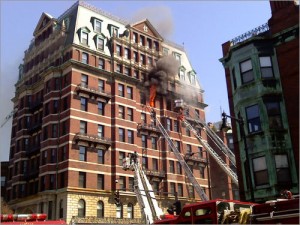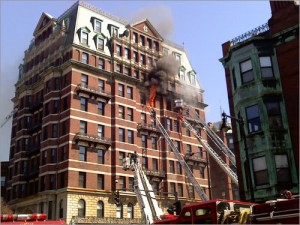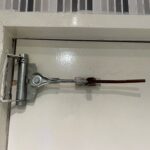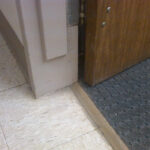 There was a 9-alarm fire last week in Boston, in a 10-story condominium building. Several residents had to be rescued by firefighters, because they didn’t evacuate the building immediately when the alarm sounded. One resident, who waited 10-15 minutes (by her estimate) to leave, found a stairwell full of smoke and a locked door to the roof. She was found at the roof door in full cardiac arrest with no pulse and no respirations. She was revived by firefighters and she survived. She’s extremely lucky.
There was a 9-alarm fire last week in Boston, in a 10-story condominium building. Several residents had to be rescued by firefighters, because they didn’t evacuate the building immediately when the alarm sounded. One resident, who waited 10-15 minutes (by her estimate) to leave, found a stairwell full of smoke and a locked door to the roof. She was found at the roof door in full cardiac arrest with no pulse and no respirations. She was revived by firefighters and she survived. She’s extremely lucky.
The mention of the “locked roof door” in the news accounts caught my attention. Coincidentally, the same day as this fire, a security integrator had asked me what type of lock was required for a roof door. I’ve written about roof door requirements before, and my informal interpretation was (and still is) that in most buildings the codes do not require egress from the stairwell to the roof. In 20+ years, I can only remember one building that had a egress path that involved the roof, and that was an unusual situation.
I posted a question about roof access and egress on a code officials’ discussion group, and so far the consensus is that the codes don’t require egress to the roof, although one fire marshal responded that he had previously worked in a jurisdiction that preferred fail safe electric locks on the roof doors. These locks would be unlocked upon fire alarm and loss of power, and were monitored by the security system. A requirement like this would be up to the local jurisdiction, and is not required by the IBC or NFPA 101/5000.
One of the code officials posted that a stairwell full of smoke within 15 minutes of the first alarm indicates that there’s an obvious problem. Maybe there were stairwell doors that weren’t closed or latched. I’m hoping to hear back from the Boston Fire Marshal and maybe we’ll find out. Here is a link to media coverage of this fire.
Photo courtesy of the Boston Globe.
You need to login or register to bookmark/favorite this content.







Leave A Comment